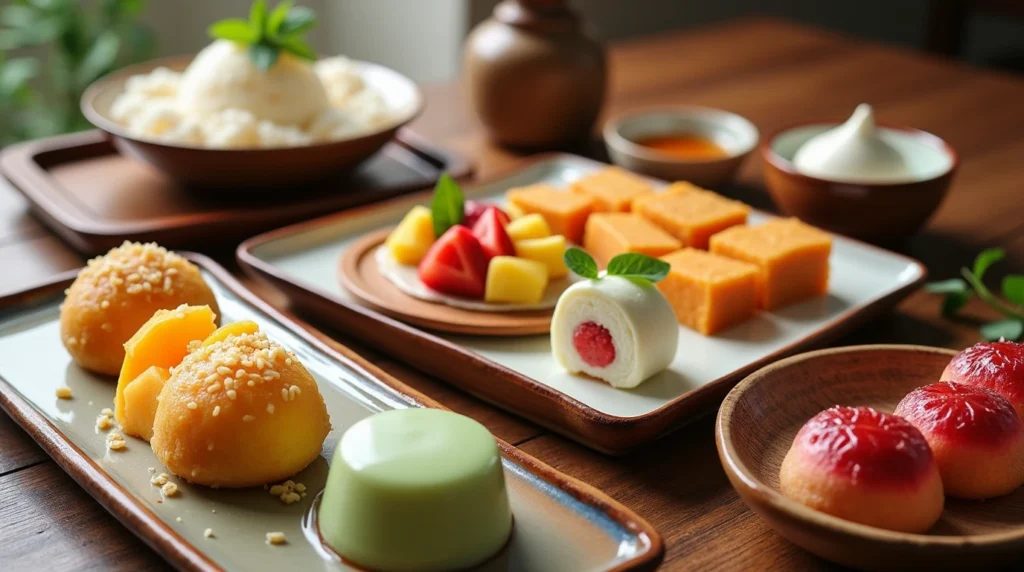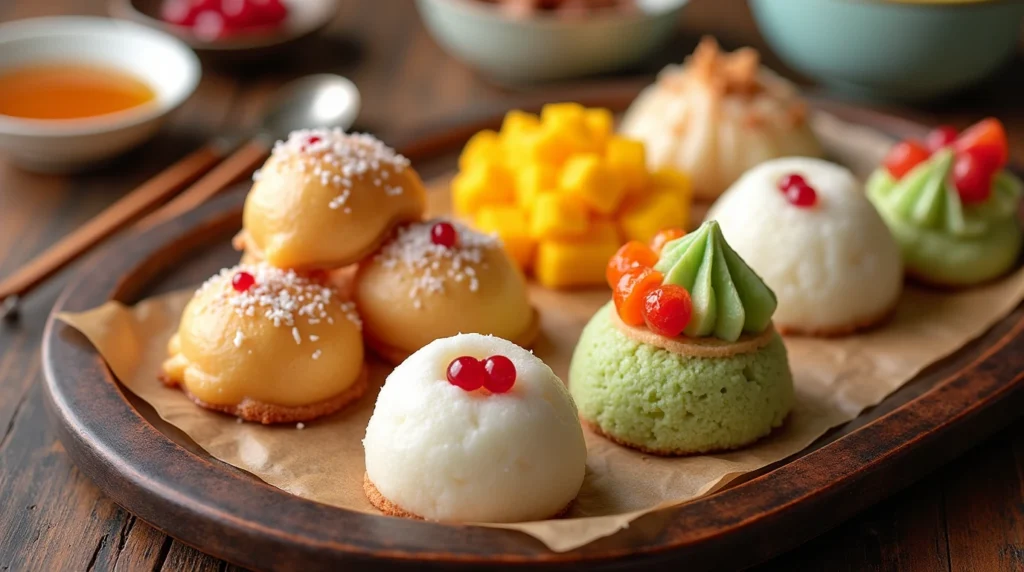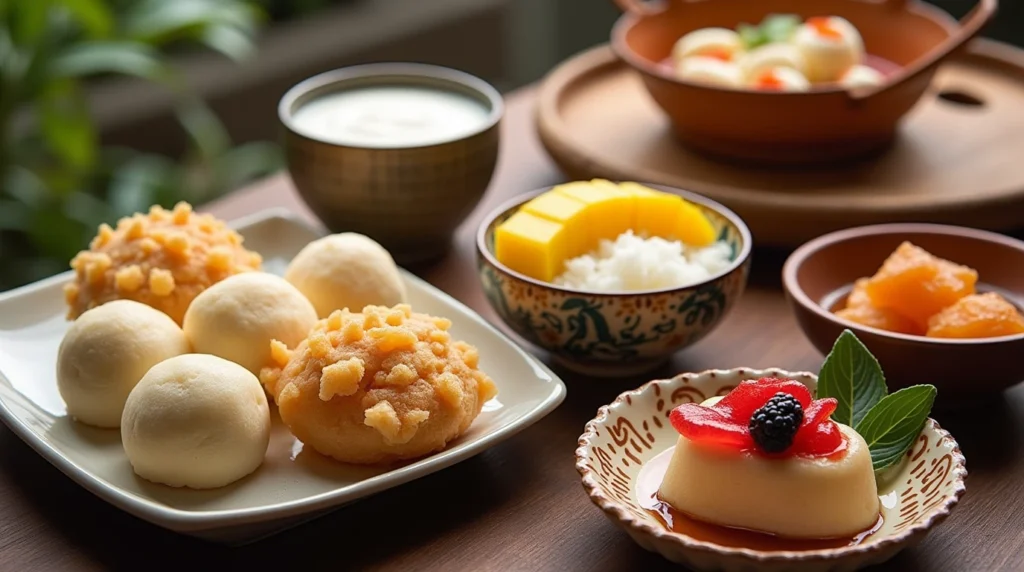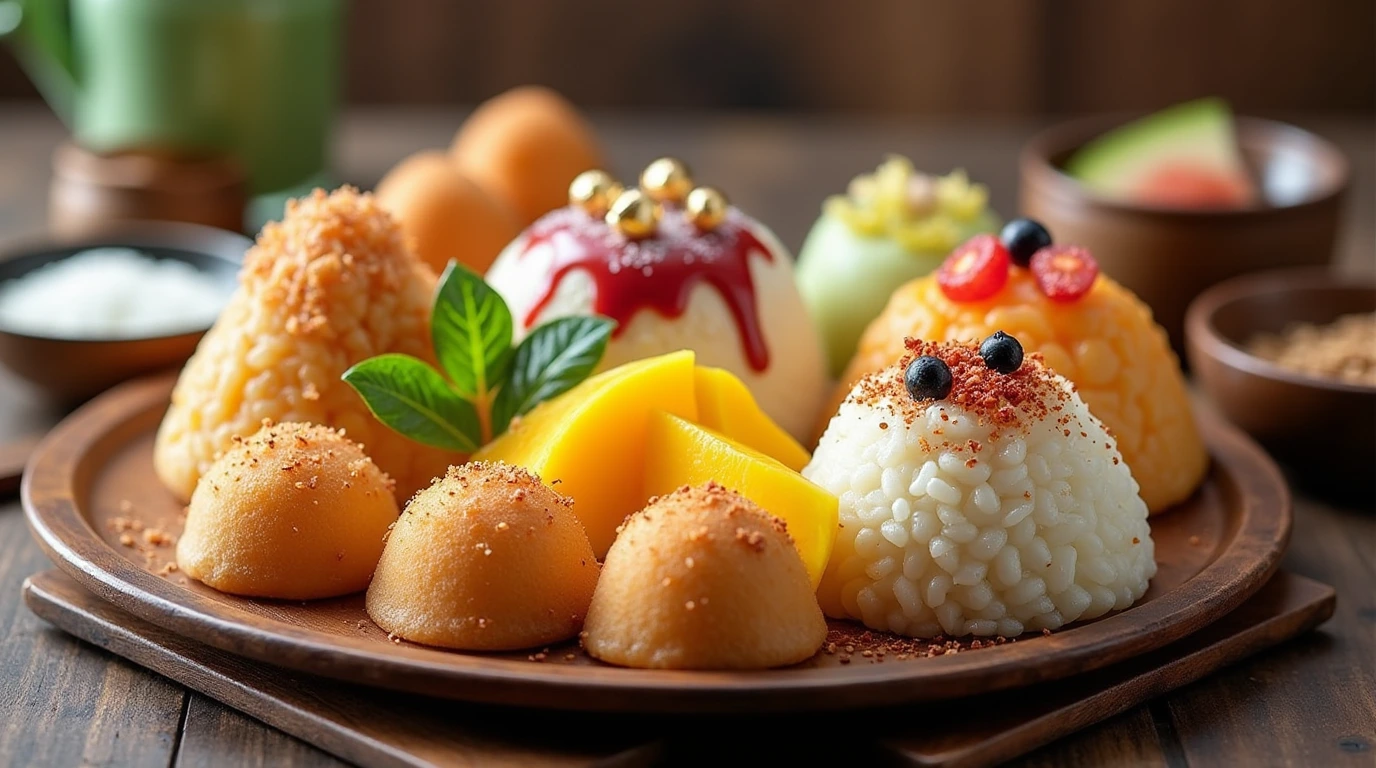Asian desserts are a delightful blend of tradition, flavor, and creativity, offering something for every palate. From the delicate sweetness of Japanese mochi to the tropical indulgence of Thai mango sticky rice, these treats showcase a rich tapestry of cultures and culinary techniques. Unlike Western desserts, which often rely heavily on sugar and butter, Asian sweets frequently highlight natural ingredients like rice, coconut milk, and tropical fruits, creating unique flavor profiles that are both satisfying and refreshing.
But Asian desserts are more than just delicious—they’re steeped in cultural significance. Many of these sweet treats have roots in centuries-old traditions, often served during festivals, celebrations, and special occasions. They carry stories of heritage and innovation, blending ancient recipes with modern interpretations.
In this post, we’ll explore what makes Asian desserts so special, diving into the unique ingredients that define them and the incredible diversity across regions. Whether you’re a foodie looking to try something new or a dessert enthusiast curious about global flavors, Asian desserts promise a journey of discovery like no other.
Table of Contents
Unique Ingredients and Flavors That Define Asian Desserts

Traditional Ingredients Used Throughout Asia
One of the most fascinating aspects of Asian desserts is how they rely on simple, natural ingredients to create a wide variety of flavors and textures. These ingredients are often tied to local farming traditions, regional climates, and cultural preferences, making each dessert a reflection of its origin. Let’s explore some of the most common traditional ingredients that form the backbone of Asian desserts.
1. Sticky Rice and Glutinous Rice Flour
Sticky rice, also known as glutinous rice, is a cornerstone of many Asian desserts. Its naturally sticky texture makes it perfect for creating soft, chewy, and slightly sweet treats. In Japan, sticky rice is pounded into a smooth dough to make mochi, a dessert that is loved for its playful texture and versatility. In Thailand, sticky rice pairs beautifully with sweet mango and coconut milk in the iconic mango sticky rice, a dessert that is as visually stunning as it is delicious.
Glutinous rice flour, derived from sticky rice, is another essential ingredient, used to make desserts like Chinese tangyuan (glutinous rice balls) and Korean tteok (rice cakes). These dishes showcase how this simple ingredient can be transformed into something extraordinary with just a few additions like sweet fillings or syrups.
2. Tropical Fruits
Tropical fruits play a starring role in many Asian desserts, bringing natural sweetness and vibrant flavors. Fruits like mango, jackfruit, and durian are commonly used in Southeast Asian countries. For example, the Philippines’ halo-halo combines shaved ice with a medley of fruits like jackfruit and bananas, along with sweet beans and jellies, creating a colorful and refreshing dessert.
Durian, often called the “king of fruits,” is another notable ingredient. Though its strong aroma can be polarizing, durian is beloved in desserts like durian crepes and ice cream for its rich, custard-like flavor.
3. Coconut Milk and Pandan Leaves
Coconut milk is a staple in Southeast Asian desserts, providing a creamy, aromatic base for many sweet treats. It’s often combined with sugar, sticky rice, or tropical fruits to create dishes like cendol—a Malaysian dessert made with pandan-flavored jelly, coconut milk, and palm sugar syrup.
Pandan leaves, known for their sweet, floral aroma, are another iconic ingredient. They’re used to infuse desserts with a unique fragrance and a natural green color, as seen in pandan chiffon cake and kuih seri muka, a Malaysian rice cake layered with pandan custard.
4. Sweet Beans and Pastes
While sweet beans might not sound like a typical dessert ingredient, they are a cornerstone of Asian sweets. Red bean paste, made from adzuki beans, is used in countless desserts across East Asia, from taiyaki in Japan to mooncakes in China. Its mild sweetness and smooth texture make it a versatile filling for buns, pancakes, and rice cakes.
Other beans, like mung beans, are also used in desserts, such as the Vietnamese bánh da lợn, a steamed layer cake with a delicate bean paste filling.
5. Jaggery and Palm Sugar
Instead of refined white sugar, many Asian desserts use natural sweeteners like jaggery and palm sugar. Jaggery, made from sugarcane or date palm sap, has a deep, caramel-like flavor that enhances dishes like Indian kheer (rice pudding) or gulab jamun (milk-based doughnuts soaked in syrup). Palm sugar, widely used in Southeast Asia, adds a rich, toffee-like sweetness to desserts like sticky rice cakes and bubur cha cha (a Malaysian coconut milk-based dessert).
Sweet and Savory Combinations
One of the most exciting and unique aspects of Asian desserts is the way they masterfully balance sweet and savory flavors. While desserts in many parts of the world focus solely on sweetness, Asian cuisine often combines contrasting elements to create harmony and depth. This approach to desserts not only reflects a cultural appreciation for balance but also results in treats that surprise and delight the taste buds.
1. Red Bean Paste: Sweetness with an Earthy Twist
Red bean paste, made from adzuki beans, is a perfect example of sweet and savory working together. While beans are typically associated with savory dishes in many cuisines, in East Asia, they are transformed into a sweet, smooth filling for desserts.
In Japan, taiyaki—fish-shaped pastries filled with red bean paste—are a beloved snack. Similarly, Chinese mooncakes often feature red bean paste as one of their traditional fillings, offering a subtle sweetness balanced by the natural earthiness of the beans. The result is a flavor profile that feels comforting and complex at the same time.
2. Salted Egg Yolk: A Rich, Savory Accent
Salted egg yolk has become a trendy ingredient in Asian desserts, but it has long been a traditional addition to many sweet treats. Its creamy, savory richness contrasts beautifully with sweet elements, creating a flavor that’s both indulgent and sophisticated.
For instance, salted egg yolk custard buns, popular in dim sum, ooze a luscious, golden filling that blends the savory saltiness of the yolk with sweetened milk and sugar. Another example is in modern pastries like salted egg yolk lava cakes, which take this classic ingredient and give it a contemporary twist.
3. Coconut and Pandan: Sweetness Enhanced by Subtle Savory Notes
Coconut milk and pandan leaves are often paired in Asian desserts, creating a balance of sweet and savory that feels light yet flavorful. The natural creaminess of coconut milk has a savory undertone that tempers the sweetness of desserts like bubur cha cha or cendol, making them rich but not overly sugary.
Pandan, with its grassy, vanilla-like aroma, further enhances this balance, as seen in desserts like kuih seri muka, a Malaysian steamed rice cake. The bottom layer of sticky rice, lightly salted to enhance the flavor, complements the sweet pandan custard layer on top.
4. Sweet and Salty Snacks: A Perfect Pairing
Many Asian desserts incorporate salty elements to enhance their sweetness. Sesame and peanut fillings, for example, are commonly used in glutinous rice balls like Chinese tangyuan. The nuttiness of sesame or peanuts, combined with a hint of salt, makes the sweet rice balls even more flavorful.
Another beloved example is crispy banana fritters served with a sprinkling of salt or paired with a sweet-salty caramel sauce. This juxtaposition of flavors elevates a simple dessert into something unforgettable.
5. Fermented Ingredients in Desserts
Fermented ingredients might seem unusual in desserts, but in Asian cuisine, they add depth and umami to sweet dishes. For instance, soy sauce or miso is sometimes incorporated into caramels or ice creams, lending a salty, savory complexity to traditionally sweet items. These innovative combinations highlight the adventurous spirit of Asian dessert makers, blending tradition with creativity.
Exotic Additions to Enhance Flavor

Asian desserts are known for their ability to surprise and delight with unexpected flavors and aromas. Many of these treats are elevated by exotic ingredients that might be unfamiliar to some but have long been cherished in their respective cultures. These additions not only enhance the overall flavor but also add a layer of uniqueness that sets Asian desserts apart from others. Let’s take a closer look at some of these exotic ingredients and how they transform sweet creations into unforgettable experiences.
1. Matcha: The Bold Elegance of Green Tea
Matcha, a finely ground green tea powder from Japan, is a popular addition to desserts thanks to its vibrant color and bold, slightly bitter flavor. Its earthy notes provide a perfect counterbalance to sweet ingredients, making it a favorite in everything from ice creams to cakes.
In desserts like matcha mochi or matcha-flavored dango, the tea’s unique taste and aroma shine through. Modern innovations like matcha tiramisu or matcha lava cakes showcase how this traditional ingredient continues to inspire creative new desserts.
2. Saffron: A Golden Touch of Luxury
Saffron, the world’s most expensive spice, is widely used in South Asian desserts to impart its golden hue and distinctive, delicate flavor. Known for its floral and slightly honey-like aroma, saffron transforms desserts into something truly luxurious.
It’s often added to kheer (Indian rice pudding), gulab jamun, or kulfi (traditional Indian ice cream), creating a warm, fragrant sweetness that feels rich and indulgent. Just a pinch of saffron is enough to elevate a simple dish into an extraordinary dessert.
3. Black Sesame: Nutty and Roasted Intensity
Black sesame is a versatile ingredient used across Asia to create desserts that are as flavorful as they are visually striking. Its deep, nutty flavor with a slightly roasted undertone adds complexity to sweets like black sesame soup in China or black sesame ice cream in Japan.
In pastries, such as black sesame buns or black sesame-filled mochi, the paste’s slightly savory quality contrasts beautifully with the sweetness of the surrounding dough, offering a perfect harmony of flavors.
4. Jaggery and Palm Sugar: Rich, Caramel-like Sweeteners
Natural sweeteners like jaggery and palm sugar are widely used in Asian desserts, offering a rich, toffee-like sweetness that refined sugar cannot replicate. Jaggery, made from sugarcane or date palm sap, is common in South Asian desserts like payasam (a type of pudding) or ladoo (sweet balls).
Palm sugar, on the other hand, is a staple in Southeast Asian sweets like cendol and kuih lapis. Its complex flavor, with notes of caramel and molasses, gives these desserts a depth that’s both comforting and satisfying.
5. Pandan: The Vanilla of the East
Pandan leaves, often referred to as “Asian vanilla,” are widely used to infuse desserts with their sweet, grassy aroma. This versatile ingredient is found in dishes like pandan chiffon cake and kuih seri muka, where its natural green color and fragrance make these treats stand out.
Pandan pairs exceptionally well with coconut milk and sticky rice, creating a tropical flavor profile that is both light and aromatic.
6. Durian: The Polarizing “King of Fruits”
Durian, often called the “king of fruits,” is infamous for its strong aroma, but for those who love it, its creamy, custard-like texture and sweet flavor make it a prized addition to desserts.
Durian ice cream, pancakes, and crepes are popular in Southeast Asia, offering a bold and unforgettable dessert experience. While its smell may take some getting used to, its unique taste rewards adventurous eaters.
7. Rose Water and Floral Accents
Floral flavors like rose water are common in South Asian and Middle Eastern-inspired desserts. Rose water lends a delicate, perfumed sweetness to treats like gulab jamun, falooda (a dessert drink), and basundi (a milk-based pudding).
In addition to rose, ingredients like orange blossom water and jasmine are sometimes used to enhance the aroma and flavor of desserts, creating a sensory experience that’s as much about fragrance as it is about taste.
Regional Diversity in Asian Desserts
East Asia
East Asia is home to some of the most iconic and beloved desserts in the world, each reflecting the region’s rich history, culture, and unique culinary traditions. Desserts from countries like Japan, China, and Korea often emphasize harmony, elegance, and the use of natural ingredients to create treats that are not only delicious but also visually stunning. Here’s a closer look at the sweet side of East Asia and what makes its desserts so special.
1. Japan: Minimalism Meets Mastery
Japanese desserts, known as wagashi, are often crafted with meticulous attention to detail, blending aesthetics with taste. They focus on subtle sweetness and natural flavors, making them a delight for both the eyes and the palate.
- Mochi: This soft and chewy rice cake is one of Japan’s most famous desserts. Mochi comes in countless variations, from plain mochi paired with sweet red bean paste to seasonal versions like sakura mochi, flavored with cherry blossoms.
- Dorayaki: A beloved snack, dorayaki features two fluffy pancakes filled with sweet red bean paste. Its simple yet satisfying taste has made it a household favorite.
- Matcha Desserts: Matcha-flavored treats like matcha ice cream, matcha roll cakes, and matcha parfaits are hugely popular. The slightly bitter notes of matcha balance perfectly with the sweetness of these desserts, offering a unique flavor profile.
Japanese desserts often highlight the beauty of seasonal ingredients and reflect a deep respect for nature. For example, during spring, cherry blossom-inspired sweets are common, while autumn brings chestnut-flavored desserts.
2. China: Tradition with a Touch of Opulence
Chinese desserts are steeped in history and often served during special occasions or festivals. Many are symbolic, representing luck, prosperity, or happiness.
- Mooncakes: These iconic pastries are a highlight of the Mid-Autumn Festival. Filled with sweet red bean paste, lotus seed paste, or salted egg yolk, mooncakes are rich and decadent, often decorated with intricate patterns.
- Tangyuan: These glutinous rice balls, often filled with black sesame or peanut paste, are served in sweet ginger soup during celebrations like the Lantern Festival. Their round shape symbolizes family togetherness and unity.
- Egg Tarts: Influenced by Portuguese pastéis de nata, Chinese egg tarts feature a flaky crust and a silky custard filling. They’re a popular dim sum dessert, loved for their creamy sweetness.
Chinese desserts often focus on textures as much as flavors, with a preference for chewy, soft, and smooth consistencies that create a multi-sensory eating experience.
3. Korea: Sweet and Refreshing Treats
Korean desserts, known as hangwa, are deeply rooted in tradition, often featuring natural ingredients like rice, honey, and nuts. In recent years, modern Korean desserts have also gained global popularity.
- Bingsu: This shaved ice dessert is a refreshing treat, especially during the summer. Topped with ingredients like sweetened red beans (patbingsu), fresh fruits, condensed milk, and even matcha powder, bingsu is as customizable as it is delicious.
- Hotteok: A warm, crispy pancake filled with a gooey mix of brown sugar, cinnamon, and nuts, hotteok is a favorite Korean street food during winter. Its combination of sweet and nutty flavors makes it irresistible.
- Tteok (Rice Cakes): Korean rice cakes come in various forms, from the colorful and chewy songpyeon, traditionally made for Chuseok (Korean harvest festival), to injeolmi, coated in roasted soybean powder for a nutty flavor.
Korean desserts often balance sweetness with texture and temperature, creating treats that are comforting yet exciting to eat.
Southeast Asia
Southeast Asia is a treasure trove of vibrant, flavorful, and diverse desserts that reflect the region’s tropical climate, rich agricultural heritage, and deep cultural traditions. From creamy coconut-based treats to desserts bursting with tropical fruit flavors, the sweets of Southeast Asia are an irresistible combination of textures, colors, and tastes. Let’s dive into what makes desserts from this region so special.
1. Coconut: The Heart of Southeast Asian Desserts
Coconut is a staple ingredient in Southeast Asian desserts, used in various forms such as milk, cream, grated flesh, and even sugar. Its creamy richness and mild sweetness make it an ideal base for countless sweet creations.
- Mango Sticky Rice (Thailand): This beloved Thai dessert combines sticky rice cooked with coconut milk and topped with slices of fresh, juicy mango. A drizzle of sweet coconut sauce and a sprinkle of toasted mung beans add extra texture and flavor.
- Bubur Cha Cha (Malaysia/Singapore): A colorful and comforting dessert soup made with sweet potatoes, taro, pandan-flavored jelly, and sago pearls, all swimming in a rich, sweet coconut milk base.
- Kakanin (Philippines): A broad category of Filipino rice-based desserts, often made with glutinous rice and coconut milk. Popular varieties include bibingka, a rice cake baked in banana leaves, and sapin-sapin, a multi-layered dessert made with coconut and flavored with ube (purple yam).
2. Tropical Fruits: Nature’s Candy
Southeast Asia’s tropical climate produces a bounty of exotic fruits that play a starring role in the region’s desserts. These fruits bring natural sweetness, vibrant colors, and unique flavors to the table.
- Durian Desserts: Known as the “king of fruits,” durian is a polarizing ingredient due to its strong aroma, but its creamy, custard-like texture makes it a favorite in desserts like durian ice cream, pancakes, and crepes.
- Halo-Halo (Philippines): This Filipino shaved ice dessert is a symphony of textures and flavors, featuring a mix of sweetened tropical fruits like jackfruit and bananas, jellies, beans, and leche flan, topped with evaporated milk and ube ice cream.
- Che Banh Lot (Vietnam): Also known as Vietnamese pandan jelly dessert, this refreshing treat features worm-like pandan jellies served with coconut milk and sweetened syrup, often accompanied by tropical fruits like lychee or mango.
3. Sticky Rice: A Versatile Favorite
Sticky rice, or glutinous rice, is a cornerstone of Southeast Asian desserts, valued for its chewy texture and ability to absorb sweet and creamy flavors.
- Khao Tom Mad (Thailand/Laos): A traditional dessert made by wrapping sticky rice, banana slices, and coconut milk in banana leaves, then steaming them to perfection. The result is a sweet and fragrant treat that’s as satisfying as it is simple.
- Puto Maya (Philippines): A sticky rice cake flavored with ginger and paired with ripe mangoes and a drizzle of thick, hot chocolate—a perfect blend of sweet, savory, and spicy flavors.
4. Palm Sugar: Rich and Caramel-Like Sweetener
Palm sugar is a widely used natural sweetener in Southeast Asian desserts, known for its deep caramel flavor and ability to enhance other ingredients.
- Cendol (Malaysia/Indonesia): A popular iced dessert featuring pandan-flavored jelly noodles, coconut milk, and a generous drizzle of palm sugar syrup. The combination of creamy, sweet, and refreshing flavors makes it a perfect treat on a hot day.
- Kuih Seri Muka (Malaysia): A two-layered dessert with a base of glutinous rice and a topping of pandan custard, sweetened with palm sugar for a rich and earthy sweetness.
5. Pandan: The Fragrant Star of Many Desserts
Pandan leaves, often referred to as the “vanilla of Southeast Asia,” impart a sweet, floral aroma and a natural green color to many desserts.
- Pandan Chiffon Cake (Indonesia/Malaysia): This light and fluffy cake is infused with pandan essence, making it aromatic and subtly sweet. Its bright green color adds visual appeal.
- Tepung Pelita (Malaysia): A traditional Malaysian dessert made with layers of pandan-flavored rice flour pudding and creamy coconut milk, served in small banana leaf cups.
South Asia

South Asia is a land of vibrant flavors, rich traditions, and culinary delights that are as diverse as the region itself. The desserts of South Asia are no exception—offering an irresistible combination of sweetness, warmth, and indulgence. Drawing on a long history of cultural influences, from Mughal royal kitchens to local traditions, these sweets often use bold spices, dairy, and natural sweeteners to create flavors that linger in the memory. Let’s explore some of the most iconic elements that make South Asian desserts so special.
1. Dairy: The Foundation of Many Sweets
Dairy plays a central role in South Asian desserts, serving as the base for many beloved treats. Milk is often boiled, condensed, or curdled to create rich and creamy textures that form the essence of these sweets.
- Rasgulla and Rasmalai (India/Bangladesh): These soft, spongy cheese balls made from chhena (curdled milk solids) are soaked in flavored syrup. While rasgulla is served in a clear sugar syrup, rasmalai is immersed in a fragrant milk sauce flavored with saffron and cardamom.
- Kheer (India/Pakistan): Known as payasam in South India, this creamy rice pudding is made by slow-cooking rice in milk with sugar, cardamom, and garnishes like nuts and dried fruits. Kheer is a festive favorite, often served during celebrations and religious ceremonies.
- Kulfi (India/Pakistan): A traditional Indian ice cream made by simmering milk until it thickens, kulfi is flavored with ingredients like saffron, pistachios, or mango, and then frozen into dense, creamy treats.
2. Natural Sweeteners: Jaggery and Honey
Natural sweeteners like jaggery (unrefined sugar made from sugarcane or palm sap) and honey are widely used in South Asian desserts, imparting a deep, caramel-like flavor that is both earthy and comforting.
- Gur Ke Chawal (India): A dessert made with jaggery, rice, and ghee, flavored with cardamom and garnished with nuts. This simple yet satisfying dish is a winter favorite in many parts of India.
- Puran Poli (India): A sweet flatbread stuffed with a mixture of jaggery and chana dal (split chickpeas), flavored with cardamom. This dessert is often enjoyed during festivals and family gatherings.
3. Spices: A Symphony of Aromas
South Asian desserts are often infused with aromatic spices, which elevate their flavor and add complexity. Cardamom, saffron, nutmeg, and cinnamon are the most commonly used, lending warmth and a distinctive fragrance to these treats.
- Gulab Jamun (India/Pakistan/Bangladesh): Perhaps the most iconic South Asian dessert, gulab jamun consists of deep-fried milk solids (khoya) soaked in rose-scented sugar syrup, often flavored with cardamom or saffron. Its name, meaning “rose berry,” reflects its floral essence.
- Sheer Khurma (India/Pakistan): A festive vermicelli pudding made with milk, sugar, dates, and nuts, sheer khurma is a staple during Eid celebrations. Its delicate spice blend of cardamom and saffron makes it irresistible.
4. Lentils and Legumes: Unexpected Sweetness
South Asian cuisine often blurs the line between sweet and savory, with legumes like lentils and chickpeas being used in desserts to add texture and richness.
- Mysore Pak (India): A fudge-like sweet made with gram flour (chickpea flour), ghee, and sugar. Its crumbly yet melt-in-the-mouth texture makes it a favorite in South India.
- Moong Dal Halwa (India): This dessert is made by slow-cooking split mung beans in ghee and sugar, resulting in a rich, nutty flavor that’s perfect for festive occasions.
5. Festivals and Sweet Traditions
Desserts are deeply tied to festivals and celebrations in South Asia, with each occasion marked by its own special treats.
- Modak (India): A steamed or fried dumpling filled with jaggery and coconut, modak is a favorite offering to Lord Ganesha during Ganesh Chaturthi.
- Barfi (India/Pakistan): A dense milk-based sweet often flavored with pistachios, rose water, or chocolate, barfi is a go-to treat for weddings, Diwali, and other joyous occasions.
- Soan Papdi (India): A flaky, melt-in-your-mouth confection made with sugar, gram flour, and ghee, soan papdi is a popular choice for gifting during festivals.
Conclusion
Asian desserts are a true reflection of the region’s diverse cultures, flavors, and traditions. From the delicate sweetness of Japanese wagashi to the rich, spiced indulgence of Indian gulab jamun, these desserts tell stories of centuries-old customs and the blending of flavors from local ingredients. Each country in Asia brings its own unique touch to the world of sweets, often emphasizing balance, harmony, and the use of fresh, natural ingredients.
One of the most beautiful things about Asian desserts is how they celebrate seasonal ingredients. In Japan, you’ll find treats that highlight the fleeting beauty of cherry blossoms in spring, while in Southeast Asia, the tropical bounty of mango, coconut, and pandan shines throughout the year. Whether it’s the creamy, nutty delights from South Asia or the refreshing, vibrant desserts from Southeast Asia, there’s always something new to discover and savor.
The use of exotic ingredients like matcha, pandan, saffron, and coconut, paired with traditional techniques that have been passed down through generations, ensures that Asian desserts are not only delicious but also rich in cultural significance. These desserts are more than just a sweet ending to a meal—they are a journey into the heart of each region’s culinary heritage.
So, the next time you enjoy an Asian dessert, take a moment to appreciate the artistry and history behind it. Whether you’re indulging in a bowl of creamy Thai coconut rice or savoring a piece of soft, chewy mochi, you’re tasting centuries of tradition and craftsmanship, all wrapped up in a bite-sized treat.
If you’ve never ventured into the world of Asian desserts, now is the perfect time to explore the endless variety and flavors they offer. There’s a whole world of sweetness waiting to be discovered, each dessert a window into the culture, passion, and creativity that define this beautiful continent.

